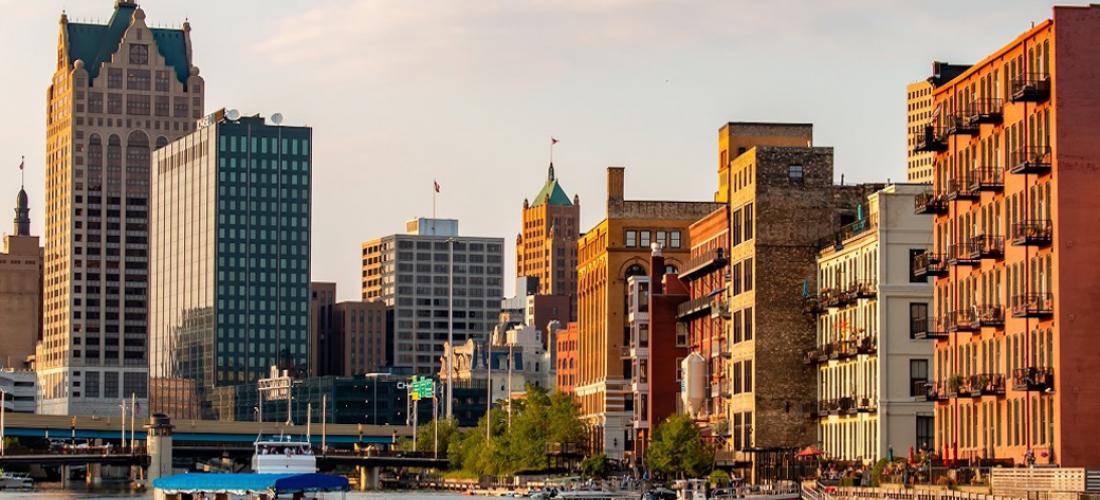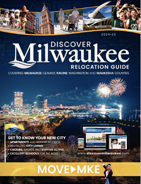

Metro Milwaukee
MILWAUKEE COUNTY: Urban Energy & Trendy Living
POPULATION: 939,487 COUNTY SEAT: Milwaukee
Milwaukee is a county of extremes. It is one of the state’s smallest counties geographically – and its most populous. Its mood ranges from the hustle and bustle of Milwaukee’s downtown to the rural quietness of River Hills, Hales Corners and Franklin. There is the nightlife revelry in the Deer District, and the quiet serenity of the 15,000-acre Milwaukee County park system, among the largest in the nation. There’s the majestic fury of Lake Michigan on a blustery November day and the quiet gurgling of the Kinnickinnic River. There are stately lakefront mansions and modest bungalows. There really is something for everyone in Milwaukee County.
Milwaukee
Milwaukee is the hub of the metropolitan area. The 31st largest city in the nation, and the fifth-largest city in the Midwest, it is known for its cleanliness, beauty and diverse population. It is a community with a big-city soul and a small-town heart. And because of Milwaukee's rich tapestry of ethnic heritages, there's a variety of neighborhoods from which to choose, each with its own distinctive flavor.
Downtown Living
Downtown Milwaukee is one of the most exciting residential areas in the metropolitan area. The city's investment in an award-winning riverwalk along the Milwaukee River, coupled with the growing demand for urban professionals to be "near the action," has spawned a multitude of upscale apartment and condominium projects. These new homes are located throughout the downtown area - in the city's central business district; just north of downtown in Brewer's Hill, one of Milwaukee's oldest neighborhoods; in the Park East corridor near Fiserv Forum and the Deer District, home of the NBA Champion Milwaukee Bucks professional basketball team; and in the trendy Third Ward and Fifth Ward/Walker's Point areas south of downtown. Of these areas, the Third Ward is the most developed. Located in a former warehouse district, its brick buildings have become a magnet for boutique shops, unique eateries, professional offices, condominiums and apartment homes.
The East Side‘s unofficial boundaries run from the Milwaukee River east to Lake Michigan and from the city limits south to Ogden Avenue. One mile wide and three miles long, it’s crammed with dozens of neighborhoods, scores of specialty stores and a extremely diverse population. It includes Prospect Avenue, where the city’s first high-rise condominiums and apartments were built and the stately homes of Newberry Boulevard and Lake Drive. The steep grandeur of Lafayette Hill slopes down to the lakefront and beautiful Bradford Beach, touted as one of the best urban beaches in the nation. It’s also the "hip" side of Milwaukee and it is as exciting as it is complex. The more than 23,000 students who attend the University of Wisconsin-Milwaukee keep the area energized. Just west of the Milwaukee River is Riverwest, one of the city's most ethnically diverse neighborhoods, which is home to a large artist population.
Milwaukee's West Side dates back to the days of Kilbourntown, when the city's movers and shakers – including the Plankintons, Mitchells, Pabsts and Brumders – built imposing mansions on what is now West Wisconsin Avenue. Story Hill is the oldest neighborhood in this area. Located just north of I-94 and east of Calvary Cemetery, the winding streets feature the highest concentration of brick, stone and stucco homes within the city.
North Side
The original home of Milwaukee's German population, the North Side is now home to much of the city's African-American population. The Northwest Side boasts the greatest abundance of single-family homes in Milwaukee. Sherman Park, which is located east of Sherman Boulevard and north of North Avenue, is known for the beautiful brick and Lannon-stone homes that sit majestically on wide, quiet streets. Bungalows are also common in this ethnically diverse neighborhood. Lindsay Park is home to the blue-domed Annunciation Greek Orthodox Church, which is located at 92nd and Congress streets and is the last major project designed by Frank Lloyd Wright.
South Side
Settled by Polish and Italian immigrants, and more recently embraced by the Hispanic and Latino community, the South Side is home to kielbasa and pierogies, pasta and cannoli, tacos and taquitos, as well as church festivals and hard-working middle-class families. Bay View is located on the South Side’s eastern edge along the shores of Lake Michigan and south of the Hoan Bridge. Started in 1867 as a company town offering puddlers’ cottages for laborers at Milwaukee Iron Company, it remained an independent suburb for several decades before it was swept up by Milwaukee’s march southward. To this day, it remains a staunchly independent community. In recent years, young professionals have flocked to Bay View, attracted by its community atmosphere and proximity to the downtown and Lake Michigan. South Kinnickinnic Avenue is the primary commercial street, but there are many eclectic specialty shops, bars and restaurants tucked along the side streets.
North Shore: Shorewood • Glendale • Whitefish Bay • Fox Point • River Hills • Bayside
Nestled among large stately trees and bordering the shimmering Lake Michigan coastline are the North Shore suburbs of Shorewood, Glendale, Whitefish Bay, Fox Point and Bayside. Here are some of the nicest homes in Milwaukee County. There are the spacious residences built by Milwaukee’s founding business barons along Lake Drive, the secluded multi-acre estates of River Hills, and the brick and stucco homes near the University of Wisconsin-Milwaukee campus. All of these communities are defined by water: Shorewood, Whitefish Bay, Fox Point and Bayside are located on Lake Michigan, while River Hills straddles the Milwaukee River.
Properties in these communities range from moderately priced to upscale to lakefront lots valued in the millions. All five villages feature a mixture of homes – from elegant, turn-of-the-century mansions to modest, newer homes owned by young families. Residents can stroll through the quaint shops and restaurants located in the downtown areas of Shorewood and Whitefish Bay or relax in the peaceful solitude of Fox Point, Bayside and River Hills, which feature large, secluded lots.
Wauwatosa
West of Milwaukee lies Wauwatosa, a community of primarily professional workers blessed with a healthy mixture of high-end homes, office buildings, retail developments and the Milwaukee Regional Medical enter. One of the earliest settlements in the area, it is ideally situated at the center of the metropolitan area, providing convenient access to the downtown and suburbs. Wauwatosa has two distinct commercial districts – the quaint and historic downtown area located in the valley on State Street, which features specialty shops and restaurants; and Mayfair Road, which is lined with office buildings and is home to Mayfair Mall, Milwaukee’s largest and most popular regional shopping center. The historic Washington Highlands has long been a sought-after residential location, but the city boasts many other charming subdivisions as well, all of which offer suburban living with close proximity to downtown Milwaukee.
West Allis/West Milwaukee
With a population of just over 60,000, West Allis ranks as one of the largest cities in Wisconsin. Once the home of the Allis-Chalmers farm equipment manufacturing empire, it has been a blue-collar town, but has witnessed a dramatic increase in home sales to young professionals. It is home to State Fair Park, which hosts the annual Wisconsin State Fair, and the Pettit National Ice Center, the site of Olympic training and time trials. The city also boasts the region’s largest farmers market, which is held several times a week during the summer months on National Avenue, west of 66th Street. West Milwaukee is a small, formerly industrial area that has been transformed into a residential and commercial community along South 43rd Street near American Family Field, home of the Milwaukee Brewers professional baseball team.
Brown Deer
Think golf and you’ll think of Brown Deer, which is located just north of Milwaukee and a short drive from downtown. The Milwaukee River and Brown Deer Park form the village’s eastern border. A modern community located just west of the exclusive village of River Hills, it developed rapidly after World War II and is home to a diverse mix of professional families. It is also a golfer’s haven, with no fewer than two country clubs and the Brown Deer Golf Course, ranked one of the best public golf courses in the nation and once a regular stop on the PGA tour. Its clubhouse is a designated historic site.
Southwest Suburbs: Franklin • Greendale • Greenfield • Hales Corners
The southwestern suburbs of Franklin, Greendale, Greenfield and Hales Corners offer both urban and rural living opportunities. They contain some of the county’s busiest commercial districts and some of the most beautiful parkland in the county. Whitnall Park and the Root River Parkway, which cut through southwestern Milwaukee County, offer acres upon acres of green space for picnicking, bicycling and other types of family enjoyment. Whitnall is home to Boerner Botanical Gardens, Wehr Nature Center hiking trails and the Whitnall Park Golf Course. There is also The Rock, located at South 76th Street and West Rawson Avenue. The Rock offers a snow park featuring skiing, snowboarding and tubing; a sports complex; Franklin Field, home of the Milwaukee Milkmen independent professional baseball team; and the mixed-use entertainment destination Ballpark Commons. Franklin is one of the state’s fastest-growing areas with residential developments springing up near Drexel, Puetz, Loomis, Rawson and Ryan roads.
Greendale, modeled after an English garden town, is one of three “Greenbelt” communities created by the federal government in the 1930s. Greenfield is one of the county’s larger communities geographically and, as its name implies, contains many parks and recreational areas. The recently developed 84South, located at Layton Avenue and South 84th Street, is a mix of apartments, offices, health care, fitness establishments, shops and restaurants.
Hales Corners, the smallest of the southwestern suburbs, is a quaint community with several residential subdivisions and commercial districts along Highway 100, Janesville Road and Forest Home Avenue near the Milwaukee-Waukesha county line.
South Shore: Cudahy • Oak Creek • St. Francis • South Milwaukee
The South Shore includes the communities of Cudahy, Oak Creek, St. Francis and South Milwaukee. The largest and fastest-growing South Shore community, Oak Creek, spans nearly 29 square miles. Located on Lake Michigan in the southeastern corner of Milwaukee County, its motto is “Where City Meets the Country.” It offers more than two dozen distinct neighborhoods, including Drexel Town Square, a development that includes restaurants, stores, offices, the Oak Creek Public Library, residential living, green space and trails. Lakeshore Commons, a major new development now under way, is creating sustainable, affordable, inclusive rental townhomes, apartments and single-family homes amid the natural beauty of the Lake Michigan shoreline and Oak Creek’s Lake Vista Park. The old-world charm and lakefront location of St. Francis has spawned several condominium and apartment projects as well. Cudahy, a company town formed by the Cudahy Packing Company in 1896, is primarily a quiet, residential community with quick access to the airport and the interstate. South Milwaukee is one of the more populous South Shore communities but retains a small-town flavor with a healthy mix of business and residential settings. It is also one of the older communities with roots that date back to the 1830s. Grant Park, one of the largest parks in the Milwaukee County Park System, is located along Lake Michigan at the eastern edge of the community.


